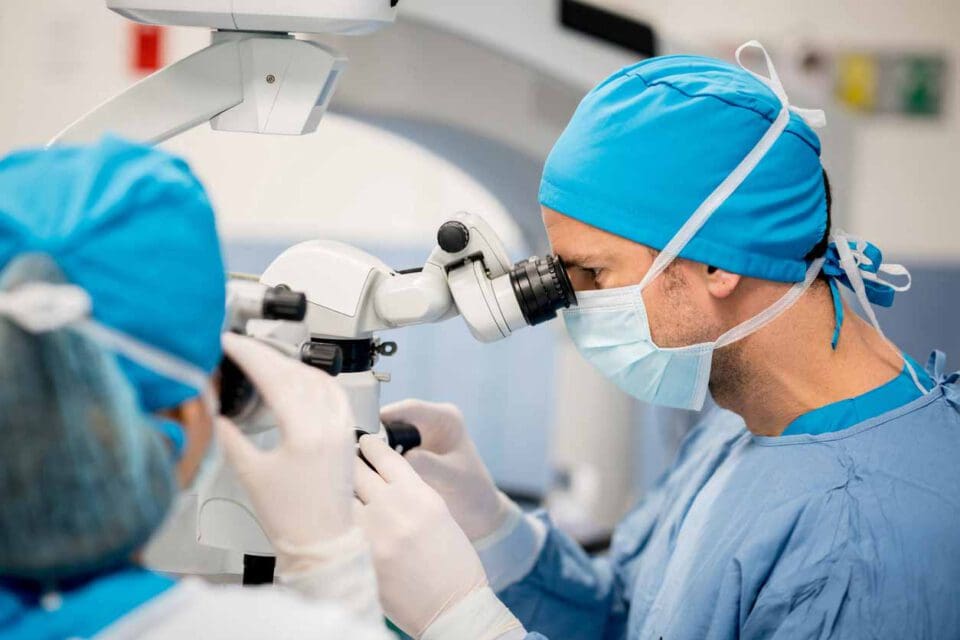Surgery for Eye Bags: Costs & Treatment Guide
Last Updated:
Table of Contents
Often termed an eyelid or eye lift since the procedure can repair and lift droopy eyelids, a blepharoplasty is a surgery to improve eye bags.
Eye bag surgery is typically deemed a cosmetic procedure. It is generally an out-of-pocket expense that is not covered by insurance. Surgery for eye bags can cost several thousand dollars.
Excess skin and fatty tissue under the eyes can cause the eyelids to droop and lead to eye bags forming under the eyes. This can detract from your appearance, so surgery for eye bags can create a more youthful look.
Eye bags can sometimes interfere with vision as well. A functional blepharoplasty is a medical procedure that may be necessary in some cases. You need to be in good health and undergo a thorough examination and discussion with your doctor prior to surgery for eye bags. The surgery typically removes fatty tissue and excess skin under the eyes. It can generally be performed in an hour or two as a same-day procedure.
Recovery from blepharoplasty typically takes a few weeks for complete healing. Be sure to follow your surgeon’s instructions on aftercare.
Surgery is not without risks, but there are several things you can do to improve recovery.
There are many other nonsurgical methods, from wrinkle creams to lifestyle changes, that can improve eye bags. Talk to your eye doctor about blepharoplasty to decide if you are a candidate and if it might be something to consider to improve your vision or appearance.

Using Insurance
Surgery for eye bags is generally not covered by insurance, as it not typically deemed medically necessary.
In some cases, when the skin actually covers part of the eyes and impairs vision, a functional blepharoplasty may be necessary. In this case, insurance may cover part of the procedure.
You deserve clear vision. We can help.
With 135+ locations and over 2.5 million procedures performed, our board-certified eye surgeons deliver results you can trust. Your journey to better vision starts here.
To obtain insurance coverage for a blepharoplasty, the visual field must be obstructed. Medical proof will generally be required to gain approval.
Costs for Eye Bag Surgery
An eye lift, or surgery for eye bags is typically performed by an ophthalmologist or an oculoplastic surgeon (a surgical ophthalmologist specialist), although general cosmetic (plastic) surgeons, ear nose and throat (ENT) surgeons, oral, and maxillofacial surgeons can perform a blepharoplasty as well.
The average cost for eye bag surgery or eye lifts is about $3,000, although this does not include fees for the hospital, medical tests, anesthesia, or prescription and necessary medications. Surgery for eye bags can range from between $2,000 and $5,000, depending on the doctor, the type of surgery being performed, and what exactly is required.
Talk to your doctor ahead of time to discuss all potential costs and fees that may be associated with a blepharoplasty.
When to Get Surgery
Commonly associated with aging, eye bags and droopy eyelids are often caused by weakened and stretching muscles that support the eyelids, which can cause fat to collect above and below them. Sagging skin around the eyes can make you look older. It can also impair your peripheral vision, as the excess skin can pull down your eyelids, making it harder to open them all the way.
Surgery for eye bags can remove the extra fat tissue and excess skin, tighten it up, and give you a more youthful look while also improving vision that is impaired by droopy, sagging eyelids. You may consider a blepharoplasty if you have:
- Drooping or sagging skin under your eyes and eyelids.
- Extra skin above your eyelids.
- Noticeable bags under your eyes.
- Extra skin around your eyelids that is impairing your field of vision.
A consultation with a surgeon before the procedure can help you to decide if surgery is a good option for you. You will need to be in good health.
Mayo Clinic reports that the majority of people that have surgery for eye bags feel that it makes them appear more youthful and alert. They are typically satisfied with the results.
A blepharoplasty can last 10 years or longer. It does not halt the aging process, but it can promote a youthful appearance for longer.
Preparing for Eye Bag Surgery
To get ready for a blepharoplasty, your doctor will first need to do a medical and visual exam after discussing your options and expectations.
A full medical history and a physical exam are usually required before any surgical procedure. Your surgeon will also do a thorough eye exam and take detailed measurements. Photos of your eyes will be taken at many different angles to plan the surgery.
Your doctor will discuss pre-op information with you. They may ask you to stop taking certain medications that can thin out your blood, such as warfarin, aspirin, and naproxen. If you smoke, you will need to stop a few weeks before surgery, as it can inhibit healing.
On the day before your surgery, eat a lighter dinner and then refrain from eating or drinking anything for 12 hours before the surgery. Take any prescribed medications that your doctor clears you to take.
Plan to have someone drive you to and from the procedure and set aside time to heal. You may wish to take up to a week off work to recover.
What to Expect
There are two main types of surgeries for eye bags: cosmetic blepharoplasty and functional blepharoplasty.
Both can be performed by a surgeon — often one who specializes in eyes, plastic surgery, or eye surgeries — as a same-day, outpatient procedure. A medically necessary, functional, blepharoplasty may be done by an ENT or an oral or maxillofacial surgeon. Both forms of blepharoplasty procedures are done the same way.
The surgery usually takes about an hour or two to complete. You may have surgery on both the lower and the upper eyelids or just one or the other. You may go under general anesthesia where you are all the way asleep or be numbed with local anesthesia depending on the complexity and duration of your specific procedure. Typically, the surgeon will start with the upper eyelid when performing a blepharoplasty on both.

If the tendon that holds the eyelid muscle is stretched or compromised, which can be a congenital condition or the result of trauma, stroke, or cataract surgery, a procedure called ptosis surgery can be performed during a blepharoplasty to repair it.
During surgery, a laser may be used to resurface or smooth the lines in the face and under the eyes as well. Typically, the stitches can be removed a week to 10 days after the surgery.
You deserve clear vision. We can help.
With 135+ locations and over 2.5 million procedures performed, our board-certified eye surgeons deliver results you can trust. Your journey to better vision starts here.
After Surgery
Recovery from a blepharoplasty typically takes a few weeks, and you may want to take up to a week off work. You will not be able to drive for at least a few days.
For the first few days, the area around your eyes is likely to be red, swollen, and bruised. The whites of your eyes may also be bloodshot and red. You will likely experience some level of discomfort for at least a few days after the procedure.
Take any prescribed medications from your surgeon. This will likely include antibiotic ointment that is applied topically.
On the day after surgery, ice for 10 to 15 minutes every hour. By the second day, ice at least every few hours. After 48 hours, move to warm compresses to enhance healing.
Blepharoplasty Recovery & Possible Side Effects
The following are some tips to follow directly after surgery:
- Clean your eyelids gently, and use only the ointments and eye drops prescribed to you.
- Try not to rub your eyes.
- Refrain from wearing makeup for several days.
- Keep your head propped up, even when sleeping.
- If you wear contacts, you will need to keep them out for up to two weeks after surgery.
- Wear sunglasses to protect your eyes from debris when outside.
- Refrain from smoking.
- Avoid swimming or strenuous activities, including lifting heavy things or straining, for several days.
- Follow all your doctor’s instructions and attend your follow-up appointments.

Your eyelids are bound to be puffy and potentially numb for a few days. It may be hard to close them all the way at first.
Your eyes may be more sensitive, irritated, and watery for up to a few weeks after surgery for eye bags. This will go away with time, just as the scarring will fade.
There is a risk for infection, bleeding, surgical complications, allergic reactions, vision issues including possible blindness, and injury to the eyelids, though these extreme side effects are very rare.
Alternatives to Surgery for Eye Bags
Instead of surgery for eye bags, you can also get dermal fillers to increase volume in the area under your eyes. This can be an optimal method if your cheeks have deflated with age, leaving bags under the eyes.
Dermal fillers are a nonsurgical option wherein a gel-like substance is injected into the space under the eyes. Costs for this procedure range from $600 to $2,000 on average.
There are many things you can do for yourself to either minimize or reduce the look of eye bags. Mayo Clinic recommends the following:
- Get enough sleep.
- Elevate your head slightly while sleeping to keep fluid from building up around your eyes.
- Decrease salt intake overall. Reduce fluid intake before bed to minimize fluid retention.
- Refrain from smoking.
- Use a cool compress on your eyes for several minutes at a time.
- Try cosmetic products to minimize the appearance of dark circles or bags under the eyes. Lightening products can help.
- Control allergy symptoms by avoiding allergens and taking allergy medicine when needed.
Additional methods for decreasing eye bags include improving collagen levels by using creams containing retinol on the skin and eating foods rich in iron and vitamin C. Drink plenty of water throughout the day, limit alcohol intake, take your makeup off before bed, and always wear sunscreen.
You can also try placing wet, steeped tea bags (such as green tea) on your eyes for a half hour or so. Clearing out your sinuses may decrease the appearance of eye bags as well.
If you have already tried these lifestyle changes and are seeking a more permanent solution for eye bags, talk to your doctor about a surgical option.
You deserve clear vision. We can help.
With 135+ locations and over 2.5 million procedures performed, our board-certified eye surgeons deliver results you can trust. Your journey to better vision starts here.
References
- Eyelid Surgery (Blepharoplasty). (February 2018). MedicineNet.
- Eyelid Surgery. (2019). American Society of Plastic Surgeons.
- Blepharoplasty. (March 2018). Mayo Clinic.
- Eyelid Surgery (Blepharoplasty) for a More Youthful Appearance. (November 2016). All About Vision.
- Eyelid Surgery. (May 2016). NHS.
- Injectable Fillers Guide. (2019). American Board of Cosmetic Surgery.
- Bags Under Eyes. (January 2018). Mayo Clinic.
- 17 Ways to Get Rid of Bags Under Your Eyes. Healthline.
This content is for informational purposes only. It may have been reviewed by a licensed physician, but is not intended to serve as a substitute for professional medical advice. Always consult your healthcare provider with any health concerns. For more, read our Privacy Policy and Editorial Policy.